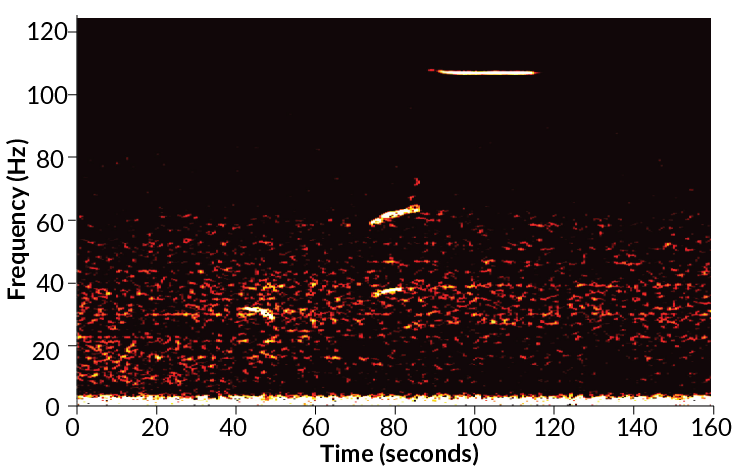
SING LOW Pygmy blue whales (one pictured) off the coast of Sri Lanka are changing their calls. Over a decade, one call component has steadily gotten deeper.
ShaneGross/iStockphoto
SALT LAKE CITY — In the Indian Ocean off the coast of Sri Lanka, pygmy blue whales are changing their tune — and they might be doing it on purpose.
From 2002 to 2012, the frequency of one part of the whales’ calls steadily fell, marine bioacoustician Jennifer Miksis-Olds reported May 25 at a meeting of the Acoustical Society of America. But unexpectedly, another part of the whales’ call stayed the same, she found.
“I’ve never seen results like this before,” says marine bioacoustician Leanna Matthews of Syracuse University in New York, who was not involved with the work. Miksis-Olds’ findings add a new twist to current theories about blue whale vocalizations and spark all sorts of questions about what the animals are doing, Matthews said. “It’s a huge mystery.”
Over the last 40 to 50 years, the calls of blue whales around the world have been getting deeper. Researchers have reported frequency drops in blue whale populations from the Arctic Ocean to the North Pacific.
Some researchers think that blue whales are just getting bigger, said Miksis-Olds, of the University of New Hampshire in Durham. Whaling isn’t as common as it used to be, so whales have been able to grow larger — and larger whales have deeper calls. Another theory blames whales’ changing calls on an increasingly noisy ocean. Whales could be automatically adjusting their calls to be heard better, kind of like a person raising their voice to speak at a party, she said.
If the whales were just getting bigger, you’d expect all components of the calls to be deeper, said acoustics researcher Pasquale Bottalico at Michigan State University in East Lansing. But the new data don’t support that, he said.
Miksis-Olds and her colleague, marine bioacoustician Sharon Nieukirk of Oregon State University in Newport, also discovered that the ocean didn’t seem to be getting any noisier: Average daily sound levels at two of the frequencies of the whales’ calls — 100 and 60 hertz — didn’t increase over the decade she studied. So the noisy ocean theory doesn’t seem to explain why the whales’ are making deeper calls either.
Story continues after graph
Call of the whale
The calls of Sri Lankan pygmy blue whales have three major components, around 100, 60 and 40 hertz. In this spectrogram of a single whale’s call, recorded in 2002, white represents the loudest sounds and black represents the quietest. Other colors represent background noise.

“No one can say for sure why they’re doing it,” Miksis-Olds said, but perhaps it’s intentional. For example, deeper calls could be a way to attract mates. Or the whales could be learning the calls from other whales that venture nearby. “There could be some cultural transmission going on,” she said. The songs of humpback whales can spread between populations, “so it is not out of the realm of possibility that pygmy blue whales could also do this.”
The calls of pygmy blue whales, Balaenoptera musculus brevicauda, have three major parts, at roughly 100, 60 and 40 hertz — like a three-tone hum. For humans, that’s almost too low to be audible. “100 hertz is barely at the edge of our hearing range,” said Miksis-Olds.“All you hear is a low moan.”
She picked out the moans in data from the Comprehensive Nuclear-Test-Ban Treaty Organization International Monitoring System, which uses underwater microphones to record ocean sounds. “It was designed to look for nuclear explosions,” Miksis-Olds said.
The highest part of the call dropped about 0.5 hertz per year, from around 107 hertz in 2002 to around 100 hertz in 2012, Miksis-Olds and Nieukirk found. It’s kind of like the difference in a teenage boy’s voice before and after puberty, Miksis-Olds said. For blue whales, it’s the biggest rate of decrease ever reported.
But the call component around 60 hertz stayed constant. (The team didn’t analyze the 40 hertz component because it was difficult to distinguish from the background noise.)
Why the whales are tweaking one part of the call and not another remains puzzling. “We’re seeing an evolution of some type,” Miksis-Olds said. “We just don’t know what aspect of the environment they’re adapting to.”






